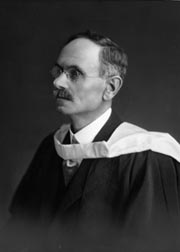John Christopher Bradshaw
This page explores the life and musical career of Lancashire-born John Christopher Bradshaw. He was head of the Christchurch Cathedral Choir, and used stern methods to make his group of boys and men one of the most outstanding choirs in the Western world.
Beginnings
Bradshaw was born in 1876 and, from his youth, held positions as a church musician. In 1901, he graduated Doctor of Music from Victoria University, Manchester.
In February 1902 he married Edith Garrod. The same month, he accepted the posts of organist and master of choristers at the Anglican Cathedral, Christchurch, and lecturer in music at Canterbury College. One of the reasons he decided to emigrate was his asthma. Bradshaw, a skilled mountaineer, climbed 16 major South Island peaks and it seemed that climbing helped cure him.
The Cathedral Choir
The Cathedral Choir sang the traditional cathedral liturgy. They gave seasonal performances of the oratorios Passion, Crucifixion and Messiah. Bradshaw was in charge at memorial services for two kings. The Cathedral Choir also farewelled Captain Scott, and welcomed the despondent expedition back from the Antarctic.
Bradshaw practised self-discipline and was a martinet to his choir. He took scant leave when his own daughter died and told a grieving lay clerk that his place was not with family but in the choir.
An example of his regime is that on one occasion Mrs White kept little Arthur, a member of the choir, at home. At practice the following morning, Bradshaw asked: Does your mother think you’ll melt?
1 Arthur never stayed away again.
The 1906 New Zealand International Exhibition and beyond
Dr Bradshaw was the organist at the 1906 New Zealand International Exhibition. He was the city organist from 1908. He gave recitals on the exhibition instrument at His Majesty’s Theatre in Manchester Street until 1917, when fire consumed both theatre and organ. In later years, Bradshaw made radio broadcasts from the Civic Theatre.
Beyond Cathedral and College, Bradshaw was conductor of the Christchurch Musical Society and Liedertafel. In 1917 he fell out with the Liedertafel and created the Christchurch Male Voice Choir. He directed this choir for 23 years. The combination of the voices of boys from the Cathedral Choir and 25 men meant that the group could perform a mixed-voice repertoire with or without piano accompaniment.
A musical educator
Bradshaw believed that children should have access to ‘good’ music and encouraged music teacher organisations.
In 1937, the Cathedral Chapter and their ever-testy organist and choirmaster parted company. Bradshaw had been dean of the Faculty of Music at Canterbury College (later Canterbury University College) since 1924 and now became a full-time professor. Early students had taken a local examination and received a certificate of proficiency; later students had their work examined in England and received a Bachelor of Music degree from the University of New Zealand.
At the University, Bradshaw introduced music appreciation courses. In 1934 he initiated weekly mid-day recitals. The campus was located at what is now the Arts Centre of Christchurch, and many members of the public went to his appreciation courses and recitals.
Bradshaw’s original output, though small, included, Cantuariensium carmen academicum, which opens the University’s annual graduation ceremonies.
Retirement and death
Ill-health forced Dr Bradshaw to retire in 1941.
In 1942 he helped establish Canterbury Public Library’s music collection by donating 600 music scores.
Edith Bradshaw died in 1944 at the age of 69. Bradshaw married again in 1946. He died in January 1950, aged 73.
Sources
- Bradshaw, John Christopher, An Encyclopedia of New Zealand, edited by A. H. McLintock, originally published in 1966. Accessed Te Ara — the Encyclopaedia of New Zealand, updated April 22, 2009.
- Brian W. Pritchard, Bradshaw, John Christopher — Biography from the Dictionary of New Zealand Biography. Te Ara — the Encyclopedia of New Zealand, updated September 1, 2010.
- Tucker, F. K., J. C. Bradshaw Mus. D. (Manchester), F.R.C.O., L.R.A.M., A.R.C.M., Hon. R.F.M.C.M. — a memoir, 1955.
Footnotes
- 1. Arthur St. John White, Epsom, Auckland, private letter to Richard L. N. Greenaway, December 2, 1974.







